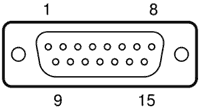MIDI/Game port

Male DA-15
| Pin | Signal | Description |
|---|
| 1 | +5V | +5V DC |
|---|
| 2 | B1 | Button 1 |
|---|
| 3 | X1 | X axis for joystick 1 (0–100 kΩ) |
|---|
| 4 | GND | Ground for B1 |
|---|
| 5 | GND | Ground for B2 |
|---|
| 6 | Y1 | Y axis for joystick 1 (0–100 kΩ) |
|---|
| 7 | B2 | Button 2 |
|---|
| 8 | +5V | +5V DC |
|---|
| 9 | +5V | +5V DC |
|---|
| 10 | B4 | Button 4 |
|---|
| 11 | X2 | X axis for joystick 2 (0–100 kΩ) |
|---|
| 12 | GND | Ground for buttons 3 and 4 (or MIDI out) |
|---|
| 13 | Y2 | Y axis for joystick 2 (0–100 kΩ) |
|---|
| 14 | B3 | Button 3 |
|---|
| 15 | +5 V | +5 V DC (or MIDI in, sometimes unconnected) |
|---|
Some joysticks supports more than 4 buttons (by using pins and input meant for the second joystick, using normally unused pins, or changing the joystick's circuits to read a 4-bit state code) but typically require a special device driver for the additional buttons to work.
Some high-end joysticks rely on multiplexing data through the 4 standard button inputs and/or the unused pins, achieving support for a rather high number of buttons and special features such as daisy-chaining, force feedback or joystick programming.
MIDI connectors
Since the game port moved to sound cards, these connectors usually double as connectors for MIDI instruments; two of the redundant +5V and GND pins of the original standard were rededicated to MIDI input and output.
